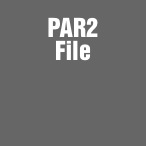A number of members have written to us asking about these weird files in PictureView that have no previews. These miscellaneous files are generally the components of a larger file (typically a movie) that has been posted to a group in pieces that require one or more separate programs to assemble.



Novice users, if you come across files without a discernable thumbnail (like those in the example above) and feel that the process of downloading, repairing, and assembling these files is not worth the effort, please feel free to ignore them. All of the non-image, non-video files have been moved to the end of each day so they should not get in the way of your normal use of the service.
NOTE: Some RAR files that are posted require a password to decode. Since PictureView is an automated Usenet service, we have no way of knowing the password that someone might have used when posting a set of RAR files.
RAR Files
RAR (Roshal Archive) is a file format similar to ZIP that can be used to archive files with or without compression and with or without encpryption. A particular file (e.g., a movie) or set of files (e.g., a collection of vacation pictures) can be saved as a single RAR file or broken up into a set of smaller RAR files for easier uploading and downloading. The RAR files available on PictureView are typically of the latter variety: a single large file like a movie broken up into a set of smaller RAR files. Once you have downloaded all of the RAR files for a particular movie, you will need to use a special program to assemble the RAR files.
If you are on the Windows platform and you are interested in assembling RAR files, you can use 7-Zip. On the Macintosh platform you can use MacPAR deLuxe.
For more information about RAR files, please see:
PAR Files
A PAR (Parity Archive) file is an error-correcting file format that can be used to repair damaged data files (e.g. RAR or 001 files), and, in some cases, even recreate a missing data file. PAR files are created for a specific set of data files (i.e., you cannot use PAR files created for Movie A to repair RAR files containing Movie B).
QuickPar is a free PAR utility available for the Windows platform. On the Macintosh platform you can use MacPAR deLuxe.
For more information about PAR and PAR2 files, please see:
Segmented Files (e.g., .001, .002, .003, etc.)
Segmented files represent another multi-part file format. The free 7-Zip can be used to assemble segmented, or 001 files (e.g., files ending in 001, 002, 003, etc.). On the Macintosh platform you can use Split & Concat.
Overview and Example (Windows Platform)
If you are interested in decoding multi-part files, please be aware that it is a multi-step process which will not always be successful because:
- Not enough complete or undamaged files in a set are available (in some cases you can look at the previous or next day to find missing pieces). Before attempting to download a set of files, make sure that the set appears to be complete (more on this below).
- Some files are protected by unknown passwords. Again, unfortunately, we have no way of knowing what password someone might have used.
- Some movie files (after being decoded) require that you download and install a “license” before playing (in which case you should close the movie and delete it). For more information, please see Rights Required to Play Video.
- Some decoded files are not movies or images, but viruses. Make sure that the file you have decoded is a valid movie or image file type (e.g., AVI, JPG, MP4, MPEG, MPG, WMV, etc.). For more information, please see Avoiding Dangerous Files.
If you’ve come this far, undaunted by warnings of varying degrees of success, then the first thing you need to do is download and install the programs you will need to decode multi-part files. On the Windows platform, you will need QuickPar and 7-Zip.
After installing QuickPar you will want to associate PAR and PAR2 files with the QuickPar program (you can do this in the program itself, using the Options button, or you can right-click on a PAR file and choose Open with…, making sure to check the Always use the selected program to open this kind of file option).
After you have installed the programs you need, your next step is to locate a set of files on Pictureview. Again, all of the muli-part files will be located at the end of each day. Also, when dealing with multi-part files you will want to familiarize yourself with the text table below the thumbnails. In fact, we recommend that you use one of the List Mode options (which allows you to view up to 100, 500, or 1000 files at once, making it easier to locate sets and perform batch downloads).
Most multi-part sets are comprised of a number of data files (e.g., RAR files) and a number of error-correcting files (i.e., PAR and PAR2 files). It is important to know the difference: data files can end with .RAR or numbers (e.g., 001, 002, 003, r01, r02, r03, etc.) but error-correcting files will always end with either PAR or PAR2.
NOTE: On the Windows platform your system can be set up to not display the file extension (i.e., the very end of a filename, like .jpg, .avi, .rar, or .par). Each file extension, which denotes the File Type, is normally associated with a specific program so that if you double-click on a particular file, Windows knows what program to use to open it. We recommend that you adjust your settings so that the file extension is always visible (open the Folder Options control panel, click the View tab, uncheck Hide extensions for know file types, and click OK).
Once you have located a set of files, review the data files to ensure that the set is complete. Although the Subject field is helpful, we recommend that you concentrate on the filename when examining a set. The filenames of a specifc set of files will all have the same beginning (like super_fun_sexy_good_movie_set2). You will need to examine the filenames to ensure that you are only downloading parts for a single set. For example, in the list below the last two items are parts of a different set.
- super_fun_sexy_good_movie_set2.par
- super_fun_sexy_good_movie_set2.part01.rar
- super_fun_sexy_good_movie_set2.part02.rar
- super_fun_sexy_good_movie_set2.part03.rar
- super_fun_sexy_good_movie_set2.vol000+01.PAR2
- super_fun_sexy_good_movie_set2.vol001+02.PAR2
- super_fun_sexy_good_movie_set2.vol003+04.PAR2
- super_fun_sexy_good_movie_set2.vol007+07.PAR2
- super_fun_sexy_good_movie_set2.vol014+12.PAR2
- super_fun_sexy_good_movie_set3.part05.rar
- super_fun_sexy_good_movie_set3.vol001+02.PAR2
The data files will be sequentially numbered (e.g., they will end in .001, .002, .003 or part01.rar, part02.rar, part03.rar or some other hopefully straightforward sequence). In the list above the data files are items 2-4 (and also item 10, but item 10 belongs to a different set). The PAR files are not sequentially numbered; there will typically be one PAR or PAR2 file at the beginning of a set and a small number of PAR2 files at the end of a set. For completeness we really only need to concentrate on the data files.
What you are looking for in the filenames is an uninterrupted sequence of files, beginning with part 1 and ending with part X. How do you determine which file is part X (i.e., the last file in the set)? Look at size of the last available data file; it should be smaller than all of the other data files in the set. If the last available data file is the same size as the preceding data files in the set, there are most likely more files in the set and you should not waste your time downloading files until you have located the missing data files. You can always look for missing files in the previous and next days in a group.
Once you have located a complete set of data files and the accompanying PAR files, batch download the files as a single zip file to a folder on your hard drive. Next, open the folder, locate the zip file you just downloaded, and unzip (i.e., extract) its contents into the same folder. Please note that all of the RAR and PAR files in a set must reside in the same folder (so if you had to download a set of files as two separate zip files, make sure that you unzip all of the files into a single folder). Windows is able to open zip files, but you can also use 7-Zip.
Your next step is to check the integrity of the files you downloaded. Assuming you have already downloaded and installed the QuickPar program, you locate and double-click on one of the PAR files (if this is the first time you are runnning QuickPar you will need to tell Windows which program to use to open PAR files). The QuickPar program will run and provide one of a number of possible results: ready to join (in which case you can click the Join button to assemble the movie), repair not needed (in which case you can exit the program), ready to recover using XXX/YYY recovery blocks (in which case you can click on the now active Repair button), or need XXX more blocks (in which case you don’t have enough of the files in the set to create the movie). We’ll assume that the second or third option occurred.
After exiting QuickPar, if the second or third option occurred (i.e., repair was not needed or a repair was performed), you can now use 7-Zip to asssemble the movie.
Locate the first date file. Typically the first data file will end in something like .01, .001, or part01.rar. (However, sometimes you will find a set that includes a series of numbered RAR files and one RAR file without numbers –treat this unnumbered file as the first data file in such cases.)
Assuming you have installed 7-Zip, right-click on the first data file, move your mouse over the 7-Zip menu, and click on the Extract Here option from the submenu. If no 7-Zip menu appears after right-clicking on the first data file, you will need to enable it by opening the 7-Zip File Manager (click on the Startmenu, click on Programs, scroll down to the 7-Zip folder, click on the 7-Zipfolder, click on 7-Zip File Manager), click the Tools menu, click on Options…, click the 7-Zip tab, and place check marks in the boxes titled Intergrate 7-Zip to shell context menu and Cascaded context menu, and then click OK to close the Options dialog.)
After clicking Extract Here, a progress dialog will appear. When complete, the progress dialog will close, and the assembled movie (or image set) will appear in the folder.
Please note that the name of the extracted movie can be anything–it will often be similar to the data files, but not necessarily. Further, before attempting to open the movie, make sure that it is a valid movie file type (e.g., .avi, .divx., .mov, .mp4, .mpeg, .mpg, .wmv, etc.). Never attempt to open a file ending in .com, .exe, .scr, or any other executable or unrecognized file type. We have no way of knowing the contents of different multi-part file sets so let caution and common sense prevail. Be prepared to occasionally have to delete an extracted file, unopened, from time to time.
Lastly, be sure to perform a little housekeeping when done, by deleting the files you downloaded that are no longer needed (i.e., the zip file/s, the data files, and the PAR files).
NOTE: We are recommending the utilities listed on this page because we have used them successfully; however, you must contact the appropriate manufacturer for support downloading, installing, and using any of the these utilities.
If a link on this page needs to be changed or updated, please send us a message.
Related Links: